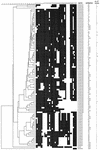Genetic biodiversity of Mycobacterium tuberculosis complex strains from patients with pulmonary tuberculosis in Cameroon
- PMID: 12791879
- PMCID: PMC156567
- DOI: 10.1128/JCM.41.6.2547-2553.2003
Genetic biodiversity of Mycobacterium tuberculosis complex strains from patients with pulmonary tuberculosis in Cameroon
Abstract
We analyzed DNA polymorphisms in 455 Mycobacterium tuberculosis complex isolates from 455 patients to evaluate the biodiversity of tubercle bacilli in Ouest province, Cameroon. The phenotypic and genotypic identification methods gave concordant results for 99.5% of M. tuberculosis isolates (413 strains) and for 90% of Mycobacterium africanum isolates (41 strains). Mycobacterium bovis was isolated from only one patient. Analysis of regions of difference (RD4, RD9, and RD10) proved to be an accurate and rapid method of distinguishing between unusual members of the M. tuberculosis complex. Whereas M. africanum strains were the etiologic agent of tuberculosis in 56% of cases 3 decades ago, our results showed that these strains now account for just 9% of cases of tuberculosis. We identified a group of closely genetically related M. tuberculosis strains that are currently responsible for >40% of smear-positive pulmonary tuberculosis cases in this region of Cameroon. These strains shared a spoligotype lacking spacers 23, 24, and 25 and had highly related IS6110 ligation-mediated (LM) PCR patterns. They were designated the "Cameroon family." We did not find any significant association between tuberculosis-causing species or strain families and patient characteristics (sex, age, and human immunodeficiency virus status). A comparison of the spoligotypes of the Cameroon strains with an international spoligotype database (SpolDB3) containing 11,708 patterns from >90 countries, showed that the predominant spoligotype in Cameroon was limited to West African countries (Benin, Senegal, and Ivory Coast) and to the Caribbean area.
Figures



Similar articles
-
Molecular characteristics of strains of the cameroon family, the major group of Mycobacterium tuberculosis in a country with a high prevalence of tuberculosis.J Clin Microbiol. 2004 Nov;42(11):5029-35. doi: 10.1128/JCM.42.11.5029-5035.2004. J Clin Microbiol. 2004. PMID: 15528691 Free PMC article.
-
First molecular epidemiology study of Mycobacterium tuberculosis in Burkina Faso.J Clin Microbiol. 2007 Mar;45(3):921-7. doi: 10.1128/JCM.01918-06. Epub 2007 Jan 24. J Clin Microbiol. 2007. PMID: 17251410 Free PMC article.
-
Mycobacterium africanum subtype II is associated with two distinct genotypes and is a major cause of human tuberculosis in Kampala, Uganda.J Clin Microbiol. 2002 Sep;40(9):3398-405. doi: 10.1128/JCM.40.9.3398-3405.2002. J Clin Microbiol. 2002. PMID: 12202584 Free PMC article.
-
Mycobacterium africanum--review of an important cause of human tuberculosis in West Africa.PLoS Negl Trop Dis. 2010 Sep 28;4(9):e744. doi: 10.1371/journal.pntd.0000744. PLoS Negl Trop Dis. 2010. PMID: 20927191 Free PMC article. Review.
-
Tuberculosis caused by Mycobacterium africanum: Knowns and unknowns.PLoS Pathog. 2022 May 26;18(5):e1010490. doi: 10.1371/journal.ppat.1010490. eCollection 2022 May. PLoS Pathog. 2022. PMID: 35617217 Free PMC article. Review.
Cited by
-
Prevalence of bovine tuberculosis in abattoirs of the littoral and Western highland regions of cameroon: a cause for public health concern.Vet Med Int. 2010;2010:495015. doi: 10.4061/2010/495015. Epub 2010 Jun 8. Vet Med Int. 2010. PMID: 20613999 Free PMC article.
-
Myths and misconceptions: the origin and evolution of Mycobacterium tuberculosis.Nat Rev Microbiol. 2009 Jul;7(7):537-44. doi: 10.1038/nrmicro2165. Epub 2009 Jun 1. Nat Rev Microbiol. 2009. PMID: 19483712 Review.
-
Comparative genomics of Mycobacterium africanum Lineage 5 and Lineage 6 from Ghana suggests distinct ecological niches.Sci Rep. 2018 Jul 26;8(1):11269. doi: 10.1038/s41598-018-29620-2. Sci Rep. 2018. PMID: 30050166 Free PMC article.
-
Beijing/W genotype Mycobacterium tuberculosis and drug resistance.Emerg Infect Dis. 2006 May;12(5):736-43. doi: 10.3201/eid1205.050400. Emerg Infect Dis. 2006. PMID: 16704829 Free PMC article.
-
Biodiversity of Mycobacterium tuberculosis in Bulgaria Related to Human Migrations or Ecological Adaptation.Microorganisms. 2022 Jan 11;10(1):146. doi: 10.3390/microorganisms10010146. Microorganisms. 2022. PMID: 35056596 Free PMC article.
References
-
- Bonora, S., M. C. Gutierrez, G. Di Perri, F. Brunello, B. Allegranzi, M. Ligozzi, R. Fontana, E. Concia, and V. Vincent. 1999. Comparative evaluation of ligation-mediated PCR and spoligotyping as screening methods for genotyping of Mycobacterium tuberculosis strains. J. Clin. Microbiol. 37:3118-3123. - PMC - PubMed
-
- Brosch, R., S. V. Gordon, M. Marmiesse, P. Brodin, C. Buchrieser, K. Eiglmeier, T. Garnier, C. Gutierrez, G. Hewinson, K. Kremer, L. M. Parsons, A. S. Pym, S. Samper, D. van Soolingen, and S. T. Cole. 2002. A new evolutionary scenario for the Mycobacterium tuberculosis complex. Proc. Natl. Acad. Sci. USA 99:3684-3689. - PMC - PubMed
-
- Castets, M., H. Boisvert, F. Grumbach, M. Brunel, and N. Rist. 1968. Tuberculosis bacilli of the African type: preliminary note. Rev. Tuberc. Pneumol. 32:179-184. (In French.) - PubMed
-
- Castets, M., and H. Sarrat. 1968. Bacteriologic aspects of mycobacteria isolated at Dakar in 1967. Bull. Soc. Med. Afr. Noire Lang. Fr. 13:463-469. (In French.) - PubMed
Publication types
MeSH terms
Substances
LinkOut - more resources
Full Text Sources

